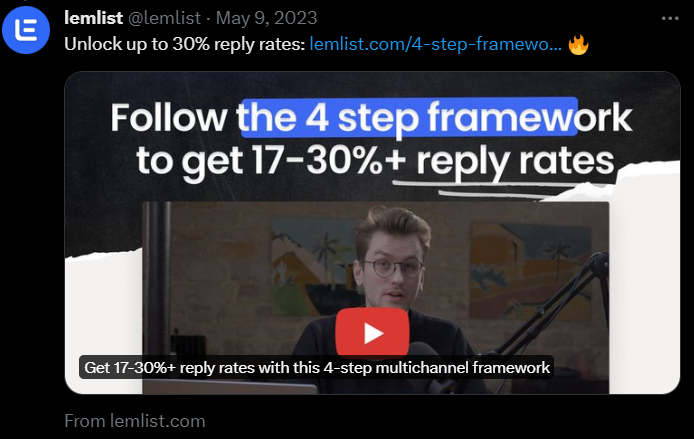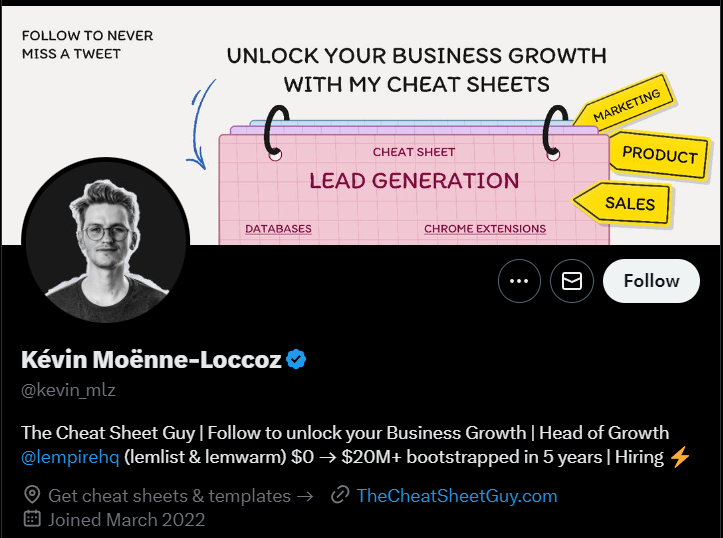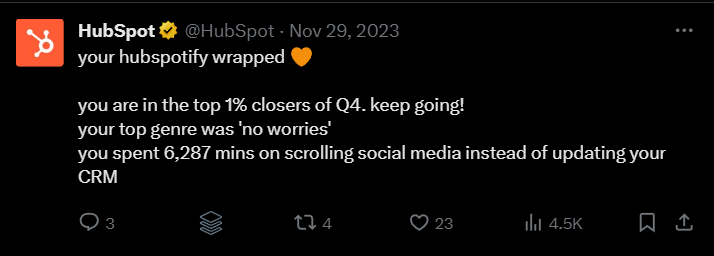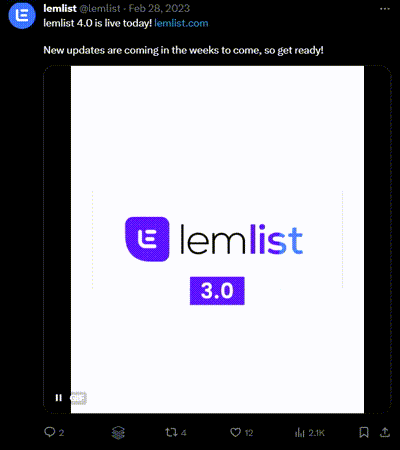Did you know you can boost your SEO results by using Twitter/X?
Twitter/X can help you get backlinks, which brings more people to your website, aka potential buyers.
More Backlinks = Higher Domain Authority = More Traffic = More Conversions = More $$$
But how does one get backlinks from Twitter/X? Which steps to take to utilize the power of this social media channel and make leads come to you?
Get answers and a step-by-step process in this actionable article!
Backlinks – The Basics
Every time someone links to your site in some way, you gain a “backlink”.
Many SEO professionals swear by backlinks as the most powerful way to build domain authority (a metric developed by Moz) – a rank position that reflects the overall strength of your site.
Backlinks are like votes of confidence for your website.
– Neil Patel.
Types Of Twitter Backlinks
#1 Profile backlinks
In your Twitter bio, these links are a direct gateway to your website.

#2 Tweet backlinks
Links within tweets direct followers to your content or promotions.

#3 Engagement backlinks
They emerge when others share your content, a product of social interaction.
Are Twitter/X Backlinks Useful In Terms Of SEO?
While the SEO advantages of Twitter backlinks are up for debate, there’s no denying the power of the social signals they generate.
Think retweets, likes, and shares.
These signals tell search engines that your content is worth a look.

So, even if the direct impact on SEO is uncertain, a tweet with loads of engagement can indirectly boost your search rankings.
Does Google Index Twitter/X Backlinks?
Not every tweet gets in, but those that do can show up in search results as a SERP Twitter/X feature.
What matters? Originality, engagement, and the tweeting account’s authority.
Nail these factors, and your tweets could very well give your site an adequate boost.
How To Build Backlinks Using Twitter/X
A. Optimize Your Twitter/X Profile
To succeed in link building, your Twitter profile needs to be optimized.
It’s often the first thing potential followers and search engines see, so make it count.
Here’s what you need:
#1 Polish Your Twitter Profile
Your Twitter profile can make or break your follower count and SEO potential.
A winning profile has a clear picture, a memorable handle, and a bio that clearly communicates your brand’s value.

Don’t forget to add some keywords to boost discoverability in Twitter searches.
More visibility means more potential backlinks.
#2 Post Engaging Tweets for Clicks and Backlinks
Engagement rules on Twitter.
To earn those coveted backlinks, focus on tweets that resonate with your audience.
Share valuable, witty, or thought-provoking content.
Jump on trending topics or current events to get the most out of the platform.
Here’s a cool example where Hubspot jumped on the ‘wrapped’ trend Spotify started.

#3 Pin Your Best Tweets (With Your Web URLs Attached!)
Pinned tweets are an SEO goldmine that often goes untapped.
Showcase your best stuff, whether it’s a blog post, promo, or big news.
Pin a tweet with a link to your website, and it’s the first thing visitors see, driving more clicks and backlinks.
And don’t overlook the website URL field in your profile.
It’s a simple way to direct traffic straight to your site.
B. Content Tricks & Tips For Better Engagement
#1 Master the Art of Embedding Links
Link embedding on Twitter is your secret weapon for SEO success.
Whether it’s in your tweets, threads, or replies, skillful link placement can earn you valuable backlinks.

Try these:
- Strategic Tweet Placement: Place links in the middle of your tweet, not at the end. This ensures they’re seen before the 280-character limit.
- Link Shorteners: Use URL shorteners like Bitly to save characters and track link performance.
- Rich Media Previews: Twitter automatically generates rich media previews for links – make sure your link’s metadata (title, description, and image) is optimized for maximum engagement.
- CTA Buttons: Encourage clicks by including a clear call-to-action (CTA) before the link, e.g., “Uncover The Answer!”.
- Avoid URL-Only Tweets: Instead of just sharing a URL, add context to your tweet – explain why the link is worth clicking.
- Thread Building: If your content requires more space, consider creating a thread and interlinking tweets within it.
- Use Hashtags Sparingly: While hashtags can boost discoverability, don’t overdo it (1-2 relevant hashtags are usually sufficient.)
- Engage with Comments: When sharing a link, actively engage with comments and replies to boost engagement, which can increase visibility.
- Retweet and Share: Encourage your followers to retweet or share your content by asking them directly.
- Use UTM Parameters: Track link performance with UTM parameters in your links, allowing you to measure the success of your Twitter campaigns accurately.
#2 Engage with Influencers for Amplified Reach
The endorsement of influencers can boost your visibility – opening the doors to more quality backlinks.
- Scout Smart: Hunt down influencers in your industry (tools like BuzzSumo or Twitter Lists can help!)
- Tag with Purpose: When you mention influencers, don’t drop generic tags – explain why they should care about your tweet in a personalized way.
- Share Their Brilliance: Be their ultimate fan! Don’t just retweet, add a comment or two to ignite conversation.
- Suggest A Collab: Once you’ve done a fair share of connecting, consider pitching a collab proposal (when they share, backlinks follow!)
#3 Use a Variety of Media
Use attention-grabbing images or GIFs to capture users’ interest and stop them from scrolling.

Consider going live or sharing short videos to provide a dynamic and engaging experience for your audience.

Take advantage of Twitter’s carousel feature to share multiple images or videos in a single tweet, offering variety in one scroll.
Ensure your profile image is captivating, whether it’s a friendly face or a recognizable brand logo, as it can influence users’ decisions to click on your tweets.

#4 Host or Attend a Chat!
A Twitter chat is a public conversation on Twitter centered around a unique hashtag.
By hosting a chat, you can engage with your followers, share your expertise, and embed links to your content.
Here’s how to do it:
- Start by choosing a topic.
- Then schedule the chat in advance and choose a date and time when your audience is most active.
- Come up with a unique hashtag for your chat to help participants find and join the conversation.
- Promote your chat through ordinary tweets, your bio text & other social media platforms.
- Prepare a list of conversation starters.
- Host the chat! Tweet your questions and interact with community answers.
- Embed links that offer additional value to your audience.
Essentially, backlinks are the fruits of many different seeds (reach, following, engagement, consistency, etc.)
If you’re consistently posting valuable stuff – you should be fine.
We really liked this simple growth hack strategy by The Futur.
The Google-Twitter/X Relationship
The real-world benefits of Google indexing Twitter links exist but they’re not as direct.
When Google indexes a Twitter link, it becomes a backlink.
However, not all Twitter links get indexed by Google, and links from social media platforms are treated differently overall.
Google prefers links with valuable content shared by high-authority accounts.
So, aim for top-notch content and build your Twitter authority to up your chances of Google indexing your links.
Track Your Progress
Once you’ve got a handle on the Google-Twitter link situation and put your Twitter backlink plan into action, it’s time to see how it’s performing.

Tools like Google Analytics, SEMrush, and Moz can help you get the scoop on backlink performance.
You’ll want to keep an eye on things like how many backlinks you’re getting, how good they are, and the traffic they bring to your site.
Use that info to adjust your strategy for better results and leave the rest behind.
Finally – Future-proof Your Tactics!
Stay on top of platform updates!
X (formerly Twitter) has undergone many changes since its acquisition.
For the current state of affairs, visit their help center.
Make it a habit to check in every month or so to keep your knowledge fresh.
Follow X on it’s own platform for fly-by insight on any changes actioned.
There you go! I hope you learned something new.
P.S. You can check out our internal linking strategy article that will help you make the most out of website linking!
Your source of actionable outreach tips and strategies that will help you get replies and grow your business.

